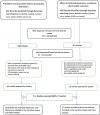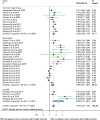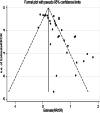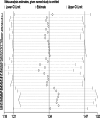Postnatal depression and its association with adverse infant health outcomes in low- and middle-income countries: a systematic review and meta-analysis
- PMID: 32698779
- PMCID: PMC7374875
- DOI: 10.1186/s12884-020-03092-7
Postnatal depression and its association with adverse infant health outcomes in low- and middle-income countries: a systematic review and meta-analysis
Abstract
Background: Postnatal Depression (PND) is a mood disorder that steals motherhood and affects the health and development of a newborn. While the impact of PND on motherhood and newborn in developed countries are well described, its epidemiology and health consequences in infant is not well known in middle-and low-income countries. The objective of this review was to determine the burden and association of PND with adverse infant health outcomes in low-and middle- income countries.
Methods: We searched observational studies written in the English language and conducted in middle-and low-income countries between December 1st, 2007, and December 31st, 2017. The CINHAL, MEDLINE, Emcare, PubMed, Psych Info, and Scopus databases were searched for the following search terms: PND, acute respiratory infection, pneumonia, diarrhea, exclusive breastfeeding, common infant illnesses, and malnutrition. We excluded studies in which the primary outcomes were not measured following a standardized approach. We have meta-analyzed the estimates from primary studies by adjusting for possible publication bias and heterogeneity. The analysis was conducted in Stata 14. The study was registered in PROSPERO protocol number CRD42017082624.
Result: Fifty-eight studies on PND prevalence (among 63,293 women) and 17 studies (among 32,454 infants) on infant health outcomes were included. PND prevalence was higher in the low-income countries (Pooled prevalence (PP) = 25.8%; 95%CI: 17.9-33.8%) than in the middle-income countries (PP = 20.8%; 95%CI: 18.4-23.1%) and reached its peak in five to ten weeks after birth. Poor obstetric history and social support, low economic and educational status, and history of exposure to violence were associated with an increased risk of PND. The risk of having adverse infant health outcomes was 31% higher among depressed compared to non-depressed postnatal mothers (Pooled relative risk (PRR) = 1.31; 95%CI: 1.17-1.48). Malnutrition (1.39; 1.21-1.61), non-exclusive breastfeeding (1.55; 1.39-1.74), and common infant illnesses (2.55; 1.41-4.61) were the main adverse health outcomes identified.
Conclusions: One in four and one in five postnatal mothers were depressed in low and middle-income countries, respectively. Causes of depression could be explained by social, maternal, and psychological constructs. High risk of adverse infant health outcomes was associated with PND. Timely screening of PND and evidence-based interventions were a pressing need in low and middle-income countries.
Keywords: Adverse infant health outcomes; And middle-income countries; Low; Meta-analysis; Postnatal depression; Systematic review.
Conflict of interest statement
None to declare.
Figures





References
-
- WHO . DEPRESSION A Global Public Health Concern. 2012.
-
- O'Hara MW. Postpartum depression: what we know. J Clin Psychol. 2009;65(12):1258–1269. - PubMed
-
- Beck CT. Postpartum depression: it isn't just the blues. Am J Nurs. 2006;106(5):40–50. - PubMed
-
- Robertson E, Grace S, Wallington T, Stewart DE. Antenatal risk factors for postpartum depression: a synthesis of recent literature. Gen Hosp Psychiatry. 2004;26(4):289–295. - PubMed
Publication types
MeSH terms
LinkOut - more resources
Full Text Sources
Medical
Miscellaneous

